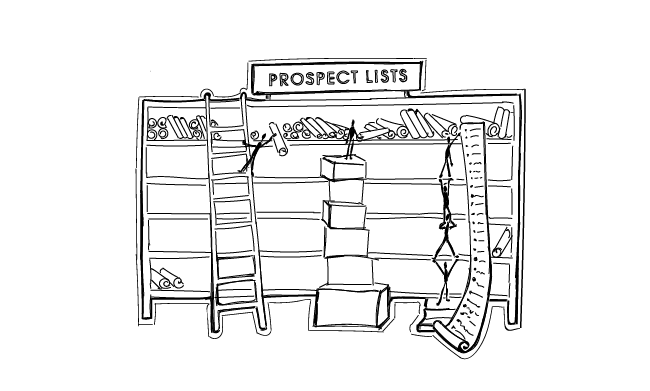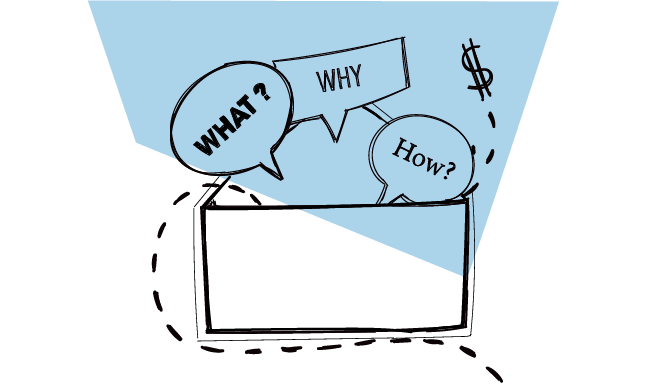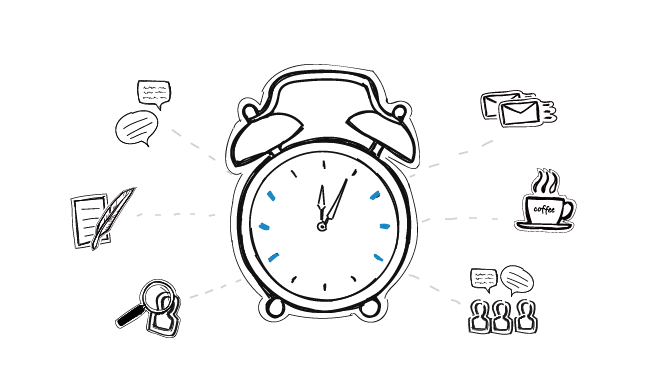Sales articles are full of advice on how to skilfully ask questions during sales interview. That’s not surprising. Questions are the exact thing that helps us move potential leads through the sales funnel. Cold callers use them during discovery calls and those who prospect might use questions while looking for the ICPs. But how to apply it to cold email senders who have just begun the conversation? Here I gathered 3 resources that will help you learn how to perfect the art of asking questions.
#1. HubSpot: 7 Intriguing Questions to Include in Your Prospecting Email
You can read the article here >>
There are a few hints here and there on the blog about switching your CTA for a question. It might be a powerful tactic in times when you feel that asking them for a call may be too big of an ask.
Here’s how to write a call to action that gets responses >>
According to HubSpot, by asking a question at the end of your email, you’ll put Zeigarnik effect into motion, that is a haunting feeling that some business has been left unfinished, and you’ll be on the prospect’s mind for a long time.
The article gives 7 possible questions to ask at the end of your cold email.
- Would you like to learn about the opportunity I think [prospect’s competitor] is missing out on?
- I see [prospect’s company] uses [X strategy]. Why?
- I see [prospect’s company] isn’t investing in [Y area]. Why not?
- Is [likely challenge or opportunity] a priority for [prospect’s boss]?
- Do you want to get on a call with [expert within your company] to discuss [prospect’s business focus]?
- Have you considered trying [X technique]?
- Should I save a [seat, ticket] for you?
I must say that this tactic seems pretty convincing. However, some of the questions (question 1 and 4) seem to be a little straightforward for a first touch email. You can add them to one of your follow-up emails though.
What about those questions?
I dug deeper into the Internet and found a nice set of qualifying questions on a blog for sales job seekers called Powerful Qualifying Questions >>
Although the article suggests using your questions during a sales call, I think we can safely apply them as our cold email CTAs.
They include:
- Have you made a purchase of this type before? How did it work out for you?
- Have you considered buying a [product type]?
- Why or why not?
- How do you see yourself using this product?
- How will it help you?
- What issues are you facing right now that this product can help you with?
- If there was one thing you could change about your [life/business], what would it be?
- What will you gain from solving this issue?
- What are the risks involved in fixing this issue?
- What are the risks of NOT fixing it?
- How long has this issue been around?
- What has held you back from fixing it so far?
They are safe questions for a couple of reasons. Most importantly, they aren’t about you. As you know, talking about yourself is one of the things people hate the most about cold emails.
So here you have it. A nice set of CTAs to try in your next cold email campaign.
There’s a small caveat. When you use a question in your cold email and you get an answer to your question. And that’s that. No calendar appointment. If you don’t do something, you will exchange emails back and forth without any prospect of switching to a call, because there won’t be a need for a more extensive talk.
#2. Daniel Pink’s The Right Questions to Get Others to Convince Themselves You’re Right
This is a great technique to use in your follow-up email.
Daniel Pink, a management consultant, has a great tactic for changing other minds. It goes like this. You think of two ridiculous techniques and then ask,
“On the scale of 1-10, how likely are you to…”
And when somebody answers something like 6, you then reply back with “Why not 7? What would need to happen to make you a 7?” This is called motivational interviewing.
Instead of using a worn-out follow-up email technique, such as an eaten-by-alligator email, maybe you can show your sense of humor through testing something like motivational interviewing to persuade your prospect to reply.
#3. The Salesman Podcast: How to Disrupt Your Competitors Relationships
Here’s a great interview to listen to every time you get in touch with prospects who use your competitor’s solutions. It teaches you the ask better questions which will help you convert them to switch. Here is the whole interview:
What’s the advice coming from that, you ask. Well, Paul Cherry gives you a few tips on asking questions. The advice you’ll hear:
- Questions can help you differentiate from the competition
- It’s better to switch ‘yes/no questions’ for descriptive openers
- Don’t be afraid to ask questions about the past and the future
- A great question makes a great first impression
- Take a step closer when you hear about the problem
Differentiate yourself from the competition with the questions you ask
Sales reps are taught to use wh-type of questions in their sales interviews, that is ‘what,’ ‘who,’ ‘where,’ ‘why’ and ‘when’ and ‘how’ Since they are so common, they sound boring and repetitive to prospective buyers. We might feel tempted to use the same questions. After all, it’s common advice to do that.
However…
When we use the same questions as everyone else, we become “me too”, it’s hard to show our unique value when we’re doing the same that everybody else does. Paul suggests ditching that kind of questions and trying another approach to questioning instead.
So spend some time rethinking the way of forming typical sales questions. Here’s a nice resource from Harvard Business Review that divides questions by their type.
Relearning the Art of Asking Questions >>
Switch yes/no for a descriptive opener
Instead of asking your prospect whether she is a decision maker, ask her what is her decision-making process. The same goes for other yes or no questions. Switch them by using phrases like “Explain to me,” “Tell me,” “Walk me through,” “Share with me,” “Help me understand,” etc. What it does, it helps to break the ice and makes people more trusting.
Don’t be afraid to ask about the past and the future
Paul says that about 87% of sales conversations are focused around the present. They don’t venture into the past or the future. Big mistake. Talking about the past or the future makes us consider the big picture.
Spend some time in the past by asking your prospects about their past experience, such as, “Tell me what worked for you in the past,” “What would you change if you could do it again?” and then switch to talking about the future by asking, “What do you see different on horizon?” or something like, “Tell me about your needs next year.”
Make a great first impression with your questions
If there’s only one thing that you should take away from this interview is that you can lose your prospect’s interest by asking boring questions. And conversely, it’s a great, original question that makes you memorable and adds up to a great first impression of you.
Lean in when you hear about a problem
When you sense that your prospect is reluctant, address the issue. Because only then will you switch their minds and get them from a “want” to “have to” stage. Ask them about it. Hear their story.
Then, switch the conversation to talking about costs. Ask them, “What’s costing you in terms of time/people/opportunity?” And lastly, ask an implication question, such as “What if you don’t address this issue what may be the impact?” And if you have an answer to that, it’s easier for you to act.
What are the takeaways from this post?
Asking a question in an email is a nice way of getting the kind of attention we want and soliciting a reply from our prospect. It’s not as aggressive as asking for a Skype call. And if executed swiftly, we can see some results with it.
Of course, putting a CTA as a question won’t work on every target. However, you may run an A/B test to see what will gather more replies: a question or a statement. And then you decide if asking questions is for you or not.
Check out this guide on A/B testing a cold email >>
If you’ve stumbled onto this blog post because you were searching for how to ask better questions in cold email on behalf of your agency’s clients, I’ve got something for you: check also these articles and videos. We’ve collected them specifically for lead generation agencies.
READ ALSO

3 Ways to Get a Quality List of Sales Leads
Question: Is there a golden way for getting a quality contact list of sales leads? The answer, sad but true: No, there isn't. But there are at least three good enough ways worth trying. All of them have their pros and cons. Not all of them will match your particular process of generating sales leads. The key is to choose those that work best for you and your company. Here's a short analysis of the three ways to help you decide where to start from.

A Guide to Asking Open-Ended Questions in Sales Emails
What is the goal of a sales email? To close a deal? Yes, eventually. But first and foremost to gain your prospect’s trust and build a fruitful, long-lasting business relationship. In real life, creating rapport between two strangers starts with a meaningful conversation. And the spark for dialogue is usually a spot-on and engaging question. It’s no different in outbound sales. Asking high-value questions in sales emails is a skill to master. Let’s take a closer look at how to do it.

A day in the Life of a SaaS Business Development Team
A business development team is a crucial element of a SaaS company. It plays an important role in business growth and revenue generation. Let’s take a look at the backstage of their job. I’ve prepared this post in collaboration with Yurii Veremchuk, the Head of Woodpecker Business Development Team, who shared some first-hand insights into the day-to-day work of his team and the challenges they face, described the tools that improve their efficiency, and gave his advice for B2B sales newbies.

